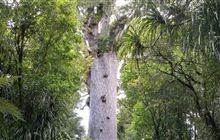DOC summer visitor insights
Archived content: This media release was accurate on the date of publication.
Introduction
New Zealanders took to the outdoors in large numbers during peak summer, according to new data released by DOC.Date: 21 April 2021
DOC’s summer 2020/21 visitor insights report shows the impact of COVID-19 related border closures—with tens of thousands of New Zealanders exploring the natural areas DOC manages this summer, but many iconic visitor sites left unusually quiet.
DOC booking data shows 75% more New Zealanders undertook a Great Walk over summer (1 December 2020 to 28 February 2021) compared to last year. Around 108,000 people camped at bookable DOC campsites, 48,000 people experienced a Great Walk and 30,000 people stayed at other bookable huts across New Zealand.
“It’s been a summer like no other. Ongoing border closures and COVID-19 alert level changes continue to impact visitor patterns across Aotearoa, but it’s awesome to see more Kiwis than ever have been enjoying their great outdoors this year, especially during holiday periods and weekends,” says DOC’s Strategy and Insights Manager Tim Bamford.
“It’s even more pleasing to see indications people have really loved holidaying in nature— often reconnecting with conservation areas special to them.”
However, the increase in New Zealand visitor numbers has not been enough to prevent a large decline in activity in many places compared to summer last year. Visitor activity data taken between 1 November 2020 and 31 January 2021 shows popular places that have been significantly quieter include: Milford Sound/Piopiotahi down 78%; Franz Josef Glacier, down 72%; and Tongariro Alpine Crossing, down 72%, compared to the same period last year.
This decline in visitors has had a heavy impact on communities in those areas, says Tim Bamford.
“DOC’s aim this summer was to support and encourage people to get out into the regions, and for people to really take advantage of the health and wellbeing benefits taking time out in nature can provide.
“Many New Zealanders are restricted by when and how far they can travel. They also have considerations such as work, school and where they can take pets. It’s tough, but not unexpected, to see more remote places have been impacted by border closures.
“At the same time places close to urban populations have either been stable or had increased use. Coastal environments were the most visited outdoor environment over summer and a lot of bookable DOC huts were at, or near full, capacity over summer weekends.”
Uretiti Beach Campsite (Northland), was the most visited DOC campground in New Zealand over summer. Pinnacles Hut (Coromandel) was the most visited non-Great Walk hut in New Zealand this summer, with close to 5,000 people staying there.
Anecdotally peoples’ behaviour has also been mixed across the country, with littering, trampling of vegetation and damaged facilities the most commonly observed visitor impacts. DOC rangers reported visitors taking dogs where they are not allowed this summer. There were also numerous observations of people inadequately prepared for trips, poor driving and vehicles in conservation areas and unsafe behaviour.
“There should be no excuse for New Zealanders endangering wildlife. Before setting out, people should check DOC’s website or pop into visitor centres to make sure they know how to keep themselves safe and protect the special places they are enjoying—including where dogs are permitted,” says Tim Bamford.
With quarantine-free travel with Australia in place, Tim Bamford is reminding everyone “to follow the Tiaki Promise, so we can ensure everyone knows to how to care for people and place around the motu.”
“With good preparation and through selecting appropriate activities, there are still plenty of opportunities to get into nature over the colder months. DOC’s seasonal web page includes options and safety information.”
To read the full report, including a look at visitor activity regionally over summer, visit www.doc.govt.nz/visitor-insights
More information
DOC’s visitor insights reports are internally focussed documents compiled to inform DOC staff about how visitation to conservation areas tracking around the country and where best to focus DOC’s heritage and visitor work.
The insights are based off the best information available at the time and so locations and date ranges for different data sets can vary (for example, the data from DOC’s activity counters vary given the data from these are manually downloaded).
Contact
For media enquiries contact:
Email: media@doc.govt.nz

